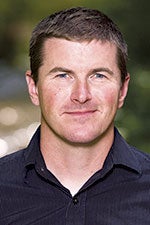Mower SWCD: Removing pollution from local streams
Published 10:17 am Thursday, June 30, 2016
By Justin Hanson
Fields, Rivers & Streams
Ten years ago, the Star Tribune ran a front-page article focusing on Minnesota’s statewide problem with homes discharging untreated sewage water directly into rivers and streams.

Justin Hanson is the district manager of the Mower Soil & Water Conservation District and the administrator of the Cedar River Watershed District
While highlighting a handful of impaired waterways, the article spotlighted Austin’s East Side Lake as the main example. Not a flattering moment for our area but we were not alone. In fact, excess residential sewage in waterways remains a problem across Minnesota.
That article back in June 2006 basically asked: “Why aren’t we doing more to stop this?” While the obvious answer seemed to be just to eliminate sewage from being dumped into waterways, the solution is more complicated.
Years ago, it was easy to hook up your home’s outgoing sewage water to a tile line or pipe that dumped into a river. It was cheap, socially accepted and awfully effective. Out of sight, out of mind.
Today, we all know that’s not OK for many reasons.
During the first half of the 20th century, Austin had swimming beaches at the Austin Mill Pond downtown, Ramsey Mill Pond area and East Side Lake. When I first saw old photos of people swimming at those places, I thought, “Those were the good old days when the rivers were clean enough for swimming.” But then I thought more about how many untreated sewage systems during that era must have been dumping directly into the Cedar River, Dobbins Creek and other streams. There likely were many.
The state eventually came up with septic systems for residential sewage treatment but at a cost from around $10,000 to $20,000. For some smaller communities, a property’s owner cost for a septic upgrade can be more than the home’s value, making for difficult decisions.
Mower County is in the final stages of a countywide initiative that identified homes directly discharging residential sewage into local streams. The initiative started with identifying direct-discharge areas and now is wrapping up with the implementation of new septic systems for those needing updates. Nearly 10 years in the making, this project has been done with sacrifice by both the public and county.
Mower County had controls in place to address this issue, requiring a septic inspection if you sold your home. This approach, however, made the timeline practically a generation long.
In recent years, Mower County and the City of Austin instead have taken a proactive approach for this issue. This has meant knocking on doors and talking with people about fixing their residential sewage problems. In some cases, this involved sending enforcement letters and having tough discussions. Many times those discussions were centered on a hefty price tag that didn’t leave homeowners with something tangible to show for it.
Thankfully, the county still moved forward. County commissioners took a leadership position, which was sometimes unpopular, in the name of progress for public health and water quality.
Today, I believe that East Side Lake (a dammed stretched of Dobbins Creek), the Cedar River State Water Trail and our other streams are healthier than they were back in those days of local swimming beaches. They also are improved from a decade ago when our local issues got statewide attention.
Our community collectively decided to find ways to work through challenges to fix the problem.
We’re also better today because there are intentional efforts to improve water quality happening all over Mower County and throughout the region in towns and along the countryside. It’s a commitment to improve our waterways. There is great momentum from the Austin Vision 2020 projects along with local governments seeking additional funding options to improve our rivers and streams.
Mower Soil & Water Conservation District and Cedar River Watershed District also are continuing our work to implement practices in farm fields that improve water quality in various ways.
Most importantly, we have people actively participating in efforts to make the water better on their own property. Intentional efforts that probably haven’t been matched before.
Today actually might just be the “good old days.”
Mower SWCD provides technical assistance to landowners with conservation practices that protect land and water resources. SWCD also administers the Cedar River Watershed District to improve water quality and reduce flooding. This column runs monthly on the last Thursday. For more, visit the Mower SWCD and CRWD websites and Facebook pages. Comments can be sent to tim.ruzek@mowerswcd.org.


